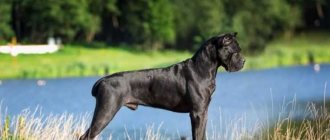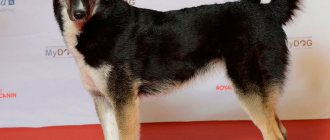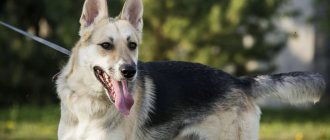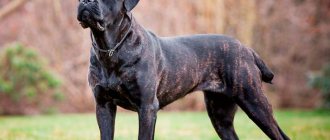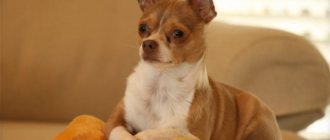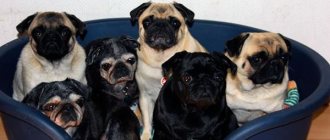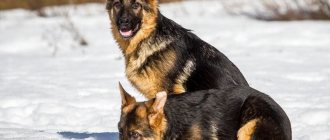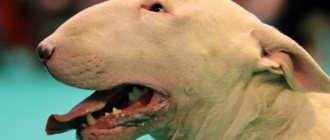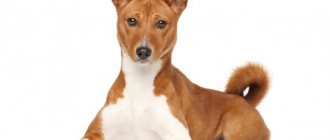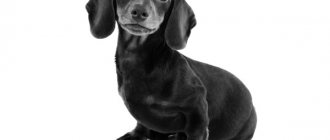Story
The origin of these animals is buried under a large layer of snow and centuries-old dust. Most likely, they belong to the descendants of wolves and a domesticated local breed. Tamed by man, they were loyal to him for many hundreds of years.
The most interesting thing is that along with low sub-zero temperatures, our comrades are also indifferent to positive temperatures. Therefore, today they can be found with equal success in both northern and southern regions.
Interest in huskies arose in the wake of great demand for fur. No one could cope with hunting in the Siberian taiga better than our heroes. Next to such an assistant, the hunter will feel protected from the attack of a predator and at the same time he himself will become a successful hunter. The high price of fur led to the fact that many hunters sought to get their hands on the husky.
But not only poachers were interested in dexterous and intelligent dogs; the Russian nobility, who were keen on hunting, were also able to get acquainted with all the advantages of the husky and even purchase several copies for their kennel. Prince Shirinsky-Shakhmatov was the first to introduce the classification of Siberian huskies to the world. Later, his method of dividing into species was recognized as incorrect. But later, it was on the basis of this work that a list of breeds was created, which is still used today.
So, today we have the following classification of huskies:
1. Factory bred on the territory of the USSR:
- West Siberian,
- Russian-European,
- Karelian-Finnish,
- East Siberian.
2. Aboriginal breeds:
- Nenets,
- Yakut,
- Evenki
3. European breeds:
- Yamthund,
- Elghund,
- Finnish Spitz,
- Buhund
- Elghund,
- Helleforshund.
West Siberian Laika
One of the most popular breeds, created by Soviet cynologists, which the USSR can really be proud of. Still, when a person works for results, and not for enrichment, it is immediately obvious.
People of that time really put all their knowledge and effort into breeding new breeds. Today we are grateful to them for this. Because the West Siberian miracle is worth it.
Work on a new species began at the end of the nineteenth century. Mansi and Khanty representatives of the group took part in the experiments. In 1920, the dog was already ready to be presented at the exhibition. It was in this year that the first standards were published.
Initially, it was used only on the territory of the USSR. It was a difficult period for the country. A lot of labor was required to raise the level of the country's economy. It was then that through the efforts of breeders, many breeds were developed that are still loved by breeders today.
The goal of developing a new breed was to create an ideal hunter , hardy, patient, and not requiring complex care. It was then that the fur trade was of great importance for the economy of the entire state and the need for easily trained huskies, subject to human control, increased. In fact, dog experts are still working on this variety, but its popularity in the world is justified. Registration with the International Canine Federation took place in 1980.
History of the breed
The West Siberian Laika was bred in the 1920s in Russia on the basis of two breeds: Khanty and Mansi.
It was at the beginning of the twentieth century that Russian cynologists created the first standards for huskies.
The formation of the breed would have been impossible if the dogs had not been selected for their hunting qualities: their eyesight, sense of smell and hearing are acutely developed, they are fast and hardy, like Russian and Estonian , as well as other hound breeds .
Dogs from two Russian kennels were crossed.
The purpose of this breed was originally hunting. West Siberian Laika is a specialist in catching large predators, fur-bearing animals, wild boars, and moose.
Description of the breed
Our heroes are not very different from the rest of the Spitz group, but they also have individual characteristics
- Height ranges from fifty-eight to sixty-five centimeters.
- Average weight is about twenty kilograms.
- Their head is wedge-shaped.
- Among the teeth you can see sharp fangs, the bite is correct.
- The nose is pigmented depending on the base color.
- The eyes are slightly slanted. The iris is painted in a brown palette.
- The ears are in the shape of a standing triangle with sharp corners.
- The fluffy tail is curled and carried on the back.
- The body is powerful, athletic, but thin.
- The limbs are muscular, dry, smooth.
The coat, like all representatives of the group, is not long, straight, slightly hard, adjacent to the body and thick. The undercoat is so developed that the dog may not experience discomfort even when in freezing rain. On the muzzle and the front part of the lower limbs the hair is somewhat shorter, while on other parts of the body. Three different colors are possible: white, wolf, red.
Breed Standard
WEST SIBERIAN LAIKA
breed standard - general appearance and type of constitution
A dog of average and above average height, strong, dry type of constitution. Type of behavior. Balanced, agile, with a well-developed orienting reaction. Malice towards a person is not typical. The characteristic gait at work is a wide, accelerated trot, alternating with a gallop. Height. Height at the withers: for males 55-62 cm, for females 51-58 cm. Height at the rump for males is 1-2 cm lower than the height at the withers, for females it is equal to or lower by 1 cm. The elongation index for males is 103-107, for bitches 104-108. Disadvantages: height below the lower limit by 2 cm in males and above the upper limit by 2 cm in females. Square format. Defects: all deviations (others) from standard height by more than 2 cm. Color. White, zoned and piebald, gray, red and brown of all shades. With a white coat, a brown nose is acceptable. Disadvantages: specks on the head and limbs to match the color. Faults: black and black with white (not zonal); specks along the body; on the head and limbs does not match the color. Brown and brindle colors put the dog outside the breed. Coat (dog). Hard straight guard hair, well developed, thick, soft and lush undercoat. Thanks to the thick, lush undercoat, the guard hairs are raised and give the impression of a uniformly luxuriantly dressed dog. The hair on the head and ears is dense and short. On the neck and shoulders it is developed more luxuriantly and forms a collar (muff), and when it meets the hair growing behind the cheekbones, it forms sideburns. At the withers the hair is elongated, especially in males. The legs are covered with short, hard, dense hair; the hair on the back is somewhat longer; it forms feathers on the hind legs, but without dewlap. On the paws, the hair is short and hard, making its way between the toes, forming a “brush”. The tail is well covered with straight, stiff hair, and on the underside the hair is somewhat longer, but without dewlap. Disadvantages: lack of undercoat or its weak development, lack of muff, tanks, gachas (not during the shedding period). Faults: wavy, curly coat, elongated with a camber on the back, dewlap on the tail, significant feathering on the front legs, dewlap on the hind legs. Having short or long hair puts a dog out of breed. Skin, muscles, bones. The skin is dense, elastic, without loose subcutaneous tissue and folds. The muscles are well developed. The bones are strong. Pastern girth in males is 11-13 cm, in females 10-12 cm. Disadvantages: any deviation from the standard. Head. Dry, pointed wedge-shaped when viewed from above, approaching in shape an elongated isosceles triangle, with a moderately wide skull, while in females it is narrower. The muzzle is sharp, long, but not narrow, with some expansion in the area of the fangs. The length of the muzzle is approximately equal to or slightly less than the length of the skull, its profile is moderately wedge-shaped. The skull is elongated, its length is noticeably greater than its width. The transition from forehead to muzzle is pronounced, but not sharp. The top line of the muzzle is parallel to the line of the forehead. The brow ridges are poorly developed. The parietal crest and occipital protuberance are well defined. The occipital part of the skull is rounded. The lips are dry, tightly fitting, without sagging or jowls. Disadvantages: convex forehead, lack of transition from forehead to muzzle. Partial depigmentation of the nose, lips and eyelids. Pronounced cheekbones. Weakly defined parietal crest and occipital protuberance, humped nose. Faults: damp, heavy head, presence of a sharp, steep transition from the forehead to the muzzle, upturned, short muzzle, square cut lips. Ears. Erect, set high, mobile, in the shape of an elongated triangle, with a poorly developed earlobe. Disadvantages: hanging, low set, little mobile. Faults: round top, large earlobe with prominent earlobe. The ears are drooping, semi-erect, on cartilage with drooping tips, putting the dog outside the breed. Eyes. Medium-sized, oval (preferably almond-shaped) with a sharply oblique eyelid, sitting somewhat deeper than other breeds of huskies. The look is alive. Eye color is dark brown and brown in any color. Disadvantages: light eyes. Flaws: round eyes, straight eyelids, bulging, white, yellow, gray, green, odd eyes. Teeth and bite. The teeth are white, large, well developed, strong, tightly fitting. The dental formula is complete. Scissor bite. Disadvantages and defects: see general provisions. Neck. Muscular, dry, oval in cross-section. Equal in length to the head. The position of the neck in relation to the longitudinal axis of the body is at an angle of 45-55°. Disadvantages: too short, long, low or vertical, sagging under the throat, chin (loaded neck). Defects: the same deviations, but expressed to a sharp degree. Withers. Well developed and pronounced, especially in males. Back. Strong, muscular, straight, wide. Disadvantages: soft, narrow, slightly springy. Faults: sagging, hunchbacked. Small of the back. Short, wide, muscular, slightly convex. Faults: long loin, straight, slightly hunchbacked. Defects: the same deviations, but expressed to a sharp degree. Croup Moderately long, slightly sloping. Disadvantages: horizontal, slightly skewed. Defects: the same deviations, but expressed to a sharp degree. Breast. Wide, deep and long, ovoid in cross-section, descending to the elbows. Disadvantages: flat or barrel-shaped, wide open, does not reach the elbows. Defects: the same deviations, but expressed to a sharp degree. Stomach. Tailored, the transition from the chest to the abdomen is poorly defined. Disadvantages: abdomen, pronounced undermining. Forelegs. The shoulders are moderately oblique, the legs are muscular, dry, and when viewed from the front, straight and parallel. The length of the legs is slightly more than half the height at the withers. The olecranon processes are developed and directed strictly backward, parallel to the axis of the body. The pasterns are not long, slightly sloping. Faults: Straight shoulders, slightly curved forearms, slightly turned in or out elbows. Straight or excessively sloping pasterns. Disadvantages in the position of the legs (size, clubfoot). Defects: the same deviations, but expressed to a sharp degree. Hind limbs. The angles of the articulations when viewed from the side are well defined. Muscular, when viewed from behind - straight and parallel. The femurs are relatively shorter than the tibiae. The hocks are set almost vertically. A plumb line, lowered from the ischial tuberosities down, runs along the front side of the metatarsus. Faults: slight straight rear, hock joints somewhat close together or turned out. Defects: the same deviations, but expressed to a sharp degree. Paws. Oval, in a ball, the fingers fit tightly to each other, while the middle fingers are slightly longer than the outer ones, arched. Dewclaws (fifth toes) on the hind legs are undesirable, and if present, it is recommended to remove them. Faults: flat paws, splayed toes. Tail. It is sharply curved in a ring on the back or on the side, as well as a sickle, but in this case it always touches the back. Its length in a straightened state should reach the hock joint or be 1-2 cm less, but not shorter. Disadvantages: elongated, sickle-shaped, not touching the back. Flaws: tail in the form of a plume, a rod, a saber.
Character
This is such a universal dog that was created to serve man that it is impossible to describe its character without taking into account the intentions of its owner. A lot depends on socialization and educational activities. This is exactly the case when your pet’s behavior completely depends on how you would like him to be and what you have done for this.
Laikas are very stubborn and will be very difficult to train for a beginner. You shouldn’t waste time and experiment with something you don’t understand, but it’s better to immediately turn to a professional.
Initially, they do not contain aggression, are very loyal to their owner, are attached to children and can become a reliable friend for them. They are efficient and diligent. But in relation to other pets they can be cocky and even hunt them.
West Siberian Laika
Standard No. 306, latest edition published 10/13/2010
Group 5 Spitz and primitive breeds
Section 2 Northern hunting dogs.
The West Siberian Laika is an average and above average height hunting dog with a strong, dry type of constitution and a somewhat elongated format.
Behavior is agile and balanced. The indicative reaction is well expressed. Malice towards people is uncharacteristic. The typical working stroke is a wide, accelerated trot, alternating with a gallop.
The coat is wild type, with well-defined guard and top hair and a dense, dense undercoat, the amount of which depends on the climate and season. In winter and in cold climates, the dog's coat rises due to the undercoat, which gives the impression of a uniform, lush coat. It forms a collar on the neck and shoulders, and sideburns behind the cheekbones. The hair at the withers is longer, especially in males. On the paws and tail the hair is short, hard and dense, somewhat longer on the back side, with feathering, but without dewlap. On the paws, short, stiff hair forms a brush. During shedding, the whiskers, fringes and mane are less pronounced.
The skin is elastic, dense, without pronounced subcutaneous fatty tissue and folds. The bones are strong and the muscles are well developed. The girth of the pastern of males is from 11 to 13 cm, in females from 10 to 12 cm.
The head, when viewed from above, is in the form of a sharp wedge, shaped like an elongated isosceles triangle. The skull is moderately wide, in males it is more voluminous. The muzzle is long, sharp, but not narrow, equal to or slightly less than the length of the skull, with a moderately wedge-shaped profile. The transition from the forehead to the muzzle is moderately expressed. The parietal crest and occipital protuberance are well defined. The cheekbones and brow ridges are weakly expressed. The lips are dry, tightly attached, not jagged. The bridge of the nose is parallel to the plane of the forehead.
The ears are in the shape of an elongated triangle, with an underdeveloped lobe, set high, mobile.
The eyes are oval or almond-shaped (preferably), dark brown or brown, medium-sized, with an oblique eyelid. Set somewhat deeper than other huskies, with a lively look.
The teeth are strong, white, large, complete, with a scissor bite.
The neck is dry, oval in cross-section, muscular, without folds or dewlap. The length of the neck is equal to the length of the head. Exit relative to the top line at an angle of 45-55o. The withers are well developed, especially in males.
The back is muscular, strong, straight, wide. The loin is wide, somewhat convex, short, and muscular. The croup is slightly sloping, of medium length.
The chest is deep, wide, long, and in cross-section resembles an egg. Dropped to the elbows. The abdomen is tucked in, the transition from the chest to the abdomen is weakly expressed.
Forelegs with moderately oblique shoulders, legs with well-developed muscles, dry, sinewy, straight and parallel when viewed from the front, with well-developed olecranon processes directed strictly backward. The length of the front legs is slightly more than half the height of the dog at the withers. The pasterns are somewhat sloping and not long.
The hind limbs have well-defined angles of articulations, well-developed muscles, and when viewed from behind they are straight and parallel. The femurs are somewhat shorter than the tibiae. Metatarsus almost vertical. A vertical line drawn from the ischial tuberosities runs along their front side.
Paws are in a ball, with tightly fitting toes, with the middle ones slightly longer than the outer ones. Dewclaws are undesirable; if present, it is recommended to remove them.
The tail is in a ring, curled over the back or side. When unrolled, it should reach the hock joint (no more than 1-2 cm shorter).
Reviews
A few reviews:
- “This is the best breed for me. I have several varieties of huskies, but these are the ones I train for hunting. They are moderately aggressive and very obedient. Talented dogs."
- “No matter what they say, this is the most faithful and devoted friend. Our Maya has been with us for fifteen years. She literally nursed our children and played with them while I did housework. Of course, it’s crazy to have a husky in an apartment, but for a private home you can’t find a better security guard.”
